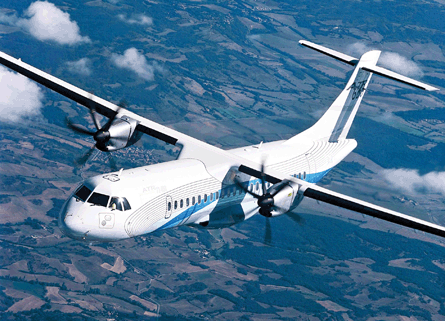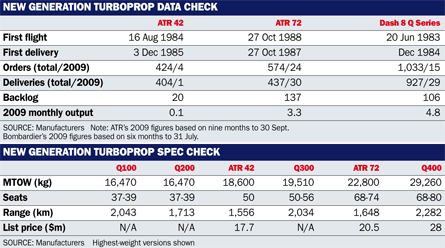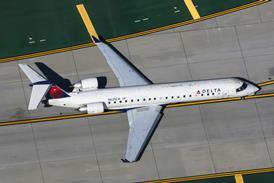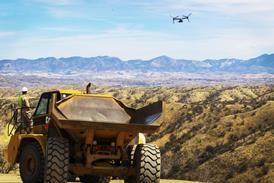As new updates come on stream, ATR and Bombardier are now evaluating their next moves in theturboprop sector
Both of the major turboprop manufacturers have introduced new variants to their aircraft familiesand are planning to add larger types to their product ranges after a first half in which the market as a whole contracted.
On 1 October, EADS-Alenia joint venture ATR officially presented the -600 series aircraft with which it is supplementing the existing -500 series of the ATR 42 and 72. The prototype's first test flights had taken place on 24 July, and by 1 Octoberit had completed around 15% of a flight-test schedule that totals 150h spread across 80 flights, according to Luigi Lombardi, ATR's senior vice-president of operations.
 |
|---|
© ATR |
The first -600 series aircraft was developed by modifying an earlier ATR 72-500, serial number 98, to include a new all-glass Thales cockpit and higher-thrust Pratt & Whitney Canada PW127M engines. In addition to improved performance in hot and high conditions, the aircraft is intended to deliver increased payload, reduced baseline weights, enhanced cabin comfort and an electronically linked maintenance system.
An ATR 42-600 will be the first of the new variants to be built from scratch, says Lombardi. Power-on is due by year-end, with first flight scheduled for early next year.
According to Lombardi, ATR must sell 150 of its -600 series aircraft to recoup its investment in the derivative. At the beginning of October, it had secured 59 orders, comprising 54 ATR 72-600s and five ATR 42-600s.
Certification is due in 2009 and Royal Air Maroc will become the first operator to take delivery of a -600 in the first half of 2011. Production of -500 series aircraft will continue for as long as there is customer demand.
UPGRADES SOUGHT
For its part, Bombardier has sought to upgrade its turboprop family with the addition of the Q400 NextGen, the first unit of which was delivered to Norwegian regional carrier Widerøe in May. The NextGen features LED lighting, new ceiling panels, "disked" window sidewalls to maximise natural light and larger overhead luggage bins.
In October 2007, Widerøe parent SAS chose to eliminate the standard Q400 from its fleet after three landing accidents occurred in quick succession. It later opted to acquire the upgraded NextGen for both its Widerøe and its Air Baltic arms.
LARGER AIRCRAFT
Both ATR and Bombardier have declared intentions to add larger aircraft to their product ranges, but time frames have yet to be confirmed, with the demands of other programmes occupying precious resources.
In May, ATR's senior vice-president of commercial John Moore told Flight International that the airframer's new product-development effort was focused on the "sub-100-seat, 90-plus market, where there's more and more potential requirement".
In June 2008, ATR chief executive Stéphane Mayer had revealed that service entry was targeted for "the second half of the next decade", with the company having accelerated the "pre-study" phase.
The new aircraft family would have at least two members, one at each end of the 70- to 98-seat spectrum, said Mayer. However, a 50-seater was also under evaluation, he added, commenting: "If there is market, we prefer to propose three. The question is whether we want to stay in the [50-seat] market and if there is a market or a business case."
Although ATR's prospective turboprop family awaits an official name, Mayer made a reference to "the -900".
An efficiency improvement in the order of 20% would be required for an aircraft programme to become viable, Moore saidin May. "It's better that we make a major step forward to justify it, otherwise you're competing with the existing products on the market," he said.
ATR had previously ruled out a stretch of the ATR 72 on the grounds that it could not deliver the required 30-40% cut in operation costs on short-haul sectors, compared with regional jets of similar capacity. By the airframer's reckoning, such a leap forward is only achievable with a larger turboprop availing of new engine technology.
Among the breakthroughs ATR is seeking from engine manufacturers are a 20% reduction in specific fuel consumption, a higher power-to-weight ratio, improved fuel flow, lower emissions, and noise levels that fall below International Civil Aviation Organisation Chapter 4 limits by "good margins".
This may require greater co-operation between the engine and propeller manufacturers from an early stage, facilitating optimisation of the gearbox and nacelle, as well as reduced drag, weight and line-replaceable unit count.
In December 2006, Pratt & Whitney Canada revealed it would invest C$1.5 billion ($1.4 billion) in R&D over five years. An additional C$360 million investment was announced in October 2008. P&WC's engines power not just ATR's turboprops, but those of Bombardier.
At the -600 series aircraft's official presentation, Lombardi confirmed that new product development remained on ATR's agenda. "We work on two major axes. The first axis is to continue to improve our product day by day, year by year. There is another axis: the fact that the market is thinking about a [higher] number of passengers. Of course, we are studying the subject, but we have not launched any new product and, for the time being, there is no decision on this. But of course, as is normal for a manufacturer, we continue to think how to improve our model today and what could arrive tomorrow."
Lombardi confirms that ATR is undertaking "a preliminary design analysis" of a possible new larger turboprop. "At the moment, there is a demand from regional customers to have a larger turboprop."
The most probable time frame for launch of a larger turboprop is "not before 2016", Lombardi adds. "I don't see a real, clear request before this. There is a market requirement, but not clear enough."
Bombardier, meanwhile, continues to ponder a stretch version of its 78-seat Q400. At the Paris air show, the airframer's commercial aircraft president Gary Scott said that the long-discussed stretch, dubbed the Q400X, was "definitely part of our future".
Scott had previously affirmed that 2013-14 was "the sort of time period we're looking at", implying a service entry well ahead of that of the next-generation ATR aircraft.
"I think [Bombardier] are in the same situation: they are thinking of something, but the market requirement is not clear enough," suggests ATR's Lombardi.
SALES OUTSTRIPPED
ATR grew its net order total in the first six months, compared with the same period of 2008, but its sales increase was outstripped by the halving of net orders for Bombardier Aerospace's Q Series aircraft.
ATR notched 28 sales in the first six months. However, existing orders for nine aircraft were cancelled, reducing the net order total to 19, of which 16 were 70-seat ATR 72-500s and three 50-seat ATR 42-500s. This compares with eight net orders in the first half of 2008 (six ATR 72s and two ATR 42s).
Canada's Bombardier, meanwhile, recorded 15 net orders for its turboprops in the first half of 2009, down from 30 in the same period of 2008. In each case, all orders were for Q400s.
 |
|---|
© Bombardier |
Overall, deliveries of turboprops edged up by around 10%, from 46 in the first half of 2008 to 50 in the same period of 2009. Where ATR outgunned Bombardier in terms of orders, the reverse applies to deliveries.
The Canadian airframer delivered 29 turboprops in the first half, up from 24 in the same period of 2008, while ATR delivered 21, down from 22. Of Bombardier's 29 deliveries, 24 were Q400s, and the rest Q300s. ATR delivered 20 ATR 72s and one ATR 42.
In the backlog stakes, the Franco-Italian joint venture has the upper hand, holding a little over 60% of the total turboprop orderbook, by aircraft, at the end of the first half of the year. It had 181 unfilled orders, comprising 162 ATR 72s and 19 ATR 42s. Bombardier, meanwhile, had unfilled orders for 113 turboprops, of which 100 were Q400s, nine Q300s and four Q200s.
In its 20-year commercial aircraft market forecast for 2009-28, Bombardier predicts a requirement for 5,800 aircraft in the 60- to 99-seat sector. This is below the comparable figure of 6,100 aircraft that appeared in the 2008-27 forecast.
 |
|---|
Demand in the 20- to 59-seat sector is forecast at 300 aircraft, down from 500 in the previous forecast, but the expectation for the 100- to 140-seat market is unchanged, at 6,300 aircraft. It is in this latter segment that Bombardier is offering its 110/130-seat CSeries mainline family.
ATR divides its forecast between the turboprop and regional jet markets. For the period 2008-27, turboprop demand is estimated at 2,900 aircraft, with 2,360 in the 61- to 90-seat category and 540 in the 30- to 60-seat category. ATR's regional jet forecast anticipates demand for 3,400 aircraft of between 91 and 120 seats, 1,515 aircraft in the 61- to 90-seat category, and 170 30- to 60-seat jets.
Source: Flight International























